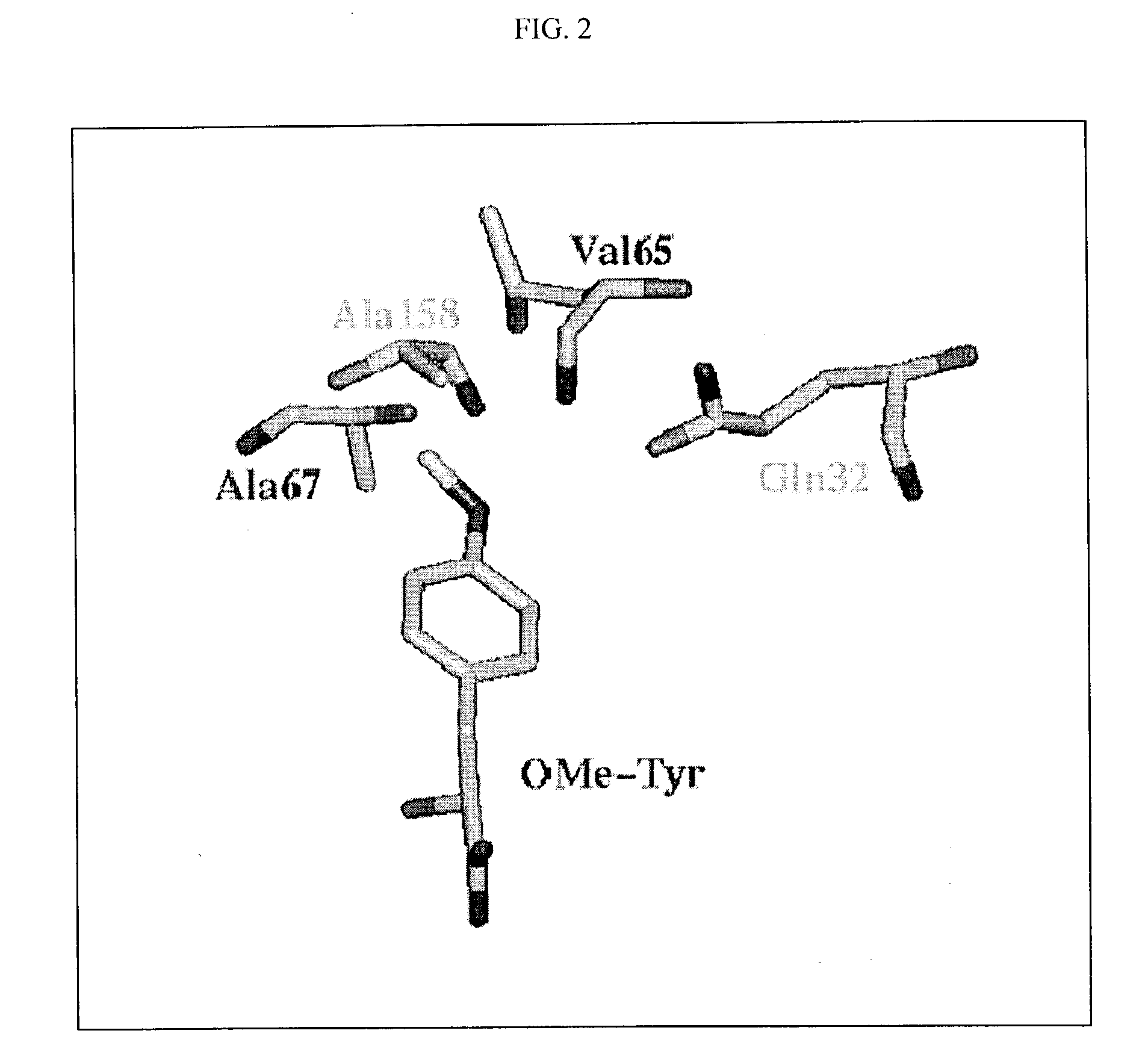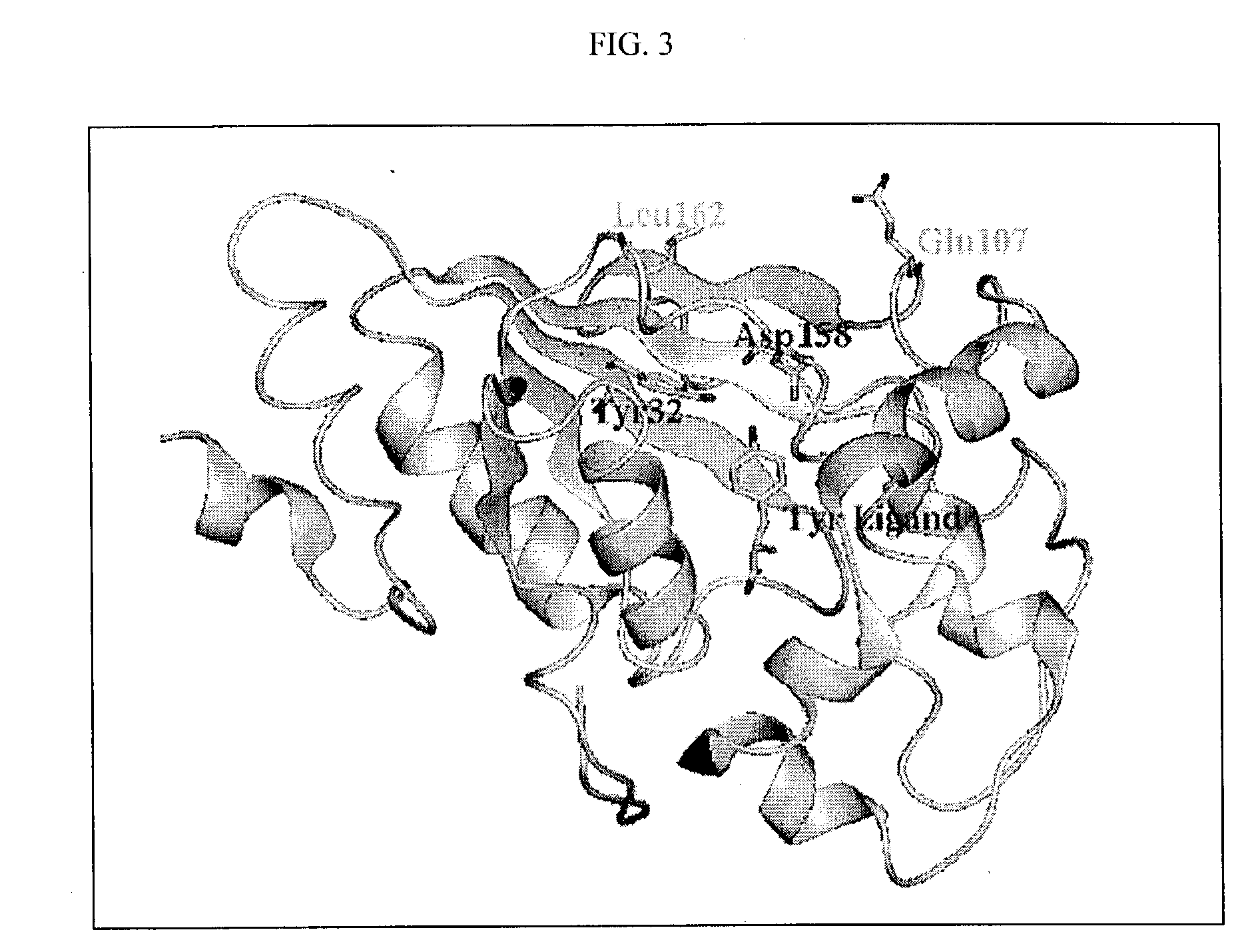COP protein design tool
a protein design and protein technology, applied in the field of protein design tools, can solve the problems of limited chemical functionality that has been accessed by this method, inability to circumvent the specificity of the synthetase, and limited mutagenesis to the 20 naturally occurring amino acids
- Summary
- Abstract
- Description
- Claims
- Application Information
AI Technical Summary
Benefits of technology
Problems solved by technology
Method used
Image
Examples
example 1
Designing Mutant Tyrosyl-tRNA Synthetase from Methanococcus janacshii for Recognizing O-methyl-L-tyrosine
[0339] Applicants have applied the COP algorithm to design mutants of tyrosyl-tRNA synthetase from Methanococcus janacshii (M. jann-TyrRS) for selective binding of OMe-Tyr (see Scheme 1).
[0340] Since the crystal structure of mj-TyrRS is not available, Applicants predicted the three-dimensional structure for wild-type mj-TyrRS, based on a combination of the STRUCTFAST sequence alignment and structure prediction algorithm with molecular dynamics (MD) including continuum solvent forces. [To select the 5 residues to modify in their experiments, Wang et al. (Science 292, 498-500, 2001) used a sequence alignment between mj-TyrRS and Bacillus stearothermophillus tyrosyl-tRNA synthetase (bs-TyrRS).] To validate the predicted structure for mj-TyrRS, MD plus continuum solvent energies were used to demonstrate that tyrosine (Tyr) is the preferred ligand over the 19 other natural amino aci...
example 2
Designing Mutatant mj-Tyr RNA Synthetase for Recognizing Naphthyl-Alanine
[0369] Using the same predicted mj-TyrRS, Applicants next designed the TyrRS to bind non-natural amino acid L-3-(2-naphthyl)alanine (naph-Ala). Two rotamers of the naphthyl-Ala were built from the Tyr ligand. Mulliken charges from QM calculation were assigned to naphthyl-Ala. Each of the two rotamers were matched into the binding site of Tyr, and clashes were calculated between the ligand and proteins.
[0370] The calculation showed that Q155 has a main-chain clash with rotamer 1 of naph-Ala. This eliminates rotamer 1 from further consideration. Rotamer 2 does not have any main-chain clash, therefore the following design steps are only applied to rotamer 2. Using a cutoff of 0.5 kcal / mol, two residues Y32 and D158 are selected as mutation sites. Each of the 20 amino acids is tried on the two positions one at a time. The mutated residue is minimized, and the interaction energies with naph-Ala and Tyr are evaluat...
example 3
Designing Mutatant mj-Tyr RNA Synthetase for Recognizing p-keto-Tyr
[0374] Using the same method above, two low energy rotamers of keto-Tyr (see panel 2 of FIG. 4) were built in Biograf. The carbonyl group is conjugate with the aromatic ring in these two rotamers. Again Mulliken charges from quantum mechanics were used for ligands. Both rotamers of keto-Tyr were matched into the binding site of Tyr in mj-TyrRS. Clashes were calculated using COP. The interactions between keto-Tyr, Tyr and residues in the binding site of mj-TyrRS were calculated as above. Based on the calculation, rotamer 2 has main chain clash with Q155, and rotamer 1 has no main chain clash, therefore rotamer 2 was not used in further steps and only rotamer I was further considered.
[0375] There are two residues having severe clash with keto-Tyr, and they are Y32 and D158. A third residue, Q155, has a less favorable interaction with keto-Tyr than Tyr. However, this residue is not considered as a clash residue, becau...
PUM
| Property | Measurement | Unit |
|---|---|---|
| Fraction | aaaaa | aaaaa |
| Threshold limit | aaaaa | aaaaa |
| Fraction | aaaaa | aaaaa |
Abstract
Description
Claims
Application Information
 Login to View More
Login to View More - R&D
- Intellectual Property
- Life Sciences
- Materials
- Tech Scout
- Unparalleled Data Quality
- Higher Quality Content
- 60% Fewer Hallucinations
Browse by: Latest US Patents, China's latest patents, Technical Efficacy Thesaurus, Application Domain, Technology Topic, Popular Technical Reports.
© 2025 PatSnap. All rights reserved.Legal|Privacy policy|Modern Slavery Act Transparency Statement|Sitemap|About US| Contact US: help@patsnap.com



